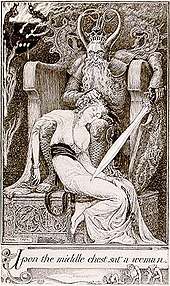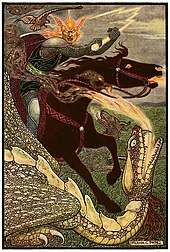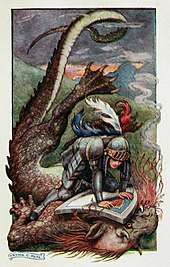Frank C. Papé
Frank Cheyne Papé, who generally signed himself Frank C. Papé (b. Camberwell, July 4, 1878 – d. Bedford, May 5, 1972), was an English artist and book illustrator. He studied at The Slade School of Fine Art, completing his studies circa 1902–04.[1] Papé was married to a fellow Slade student, illustrator Alice Stringer.

Works
Papé's first known work, for Emile Clement's Naughty Eric and Other Stories from Giant, Witch, and Fairyland, published in 1902, remains extremely rare. One copy is held by The British Library. An original pen and ink illustration from one of the stories, 'The Magic Stone', has been found in Sussex, England.[2]

Papé's next earliest illustrations are found in books for children from around 1908, including The Toils and Travels of Odysseus (1908), a translation of The Odyssey by C.A. Pease; and Bunyan's The Pilgrim's Progress (1910). During the second decade of the 20th Century he made extensive contributions to the a number of collections of fairy, folk and other children's tales, as well as illustrating a collection of the Psalms.
By 1911, Papé was a highly successful book illustrator. World War I brought a decline in Britain's illustrated book market, affecting Papé's livelihood. He enlisted in the Royal Army Service Corps in 1915 and served on the Greco-Bulgarian front.[3]
Papé's career was revived in the early 1920s through his illustrations for a number of books by James Branch Cabell, which brought him new acclaim in the United States. These books from Biography of the Life of Manuel series issued by the London publishing house The Bodley Head, included Jurgen, A Comedy of Justice (1921, originally in a limited edition), The High Place, Something about Eve and The Cream of the Jest. These illustrations often wittily paralleled the double entendres in Cabell's writing. In the preface to the 1925 edition of his book Figures of Earth, Cabell praised the fitness of Papé's style for these works.
The success of these editions led to Bodley Head commissioning illustrations by Papé for books of Anatole France, including The Revolt of the Angels (1924) and Penguin Island (1925), in addition to those for the works of Rabelais. He also designed book covers for other authors, including Rafael Sabatini (The Life of Cesare Borgia, 1924).
Circa 1925, Papé began to provide illustrations for Uncle Ray's Corner, a weekly children's column by Wisconsin writer Ramon Coffman that was syndicated in the United States by the Cleveland Plain Dealer. This collaboration, which lasted for several decades, led to a number of book illustration commissions, including Uncle Ray's Story of the Stone-Age People (1936) and The Child's Story of Science (1939).[4]
Papé was also sought after as a designer of bookplates, including one for Dennis Wheatley. He also illustrated Wheatley's 1933 biography of Charles II, Old Rowley, and created dust jacket illustrations for the first editions of several Wheatley novels, including The Devil Rides Out (1935), Strange Conflict (1941), The Haunting of Toby Jugg (1948), and To the Devil a Daughter (1953).
During the late 1930s, Papé's career faltered. Starting in 1945, he continued his collaboration with Ramon Coffman when Coffman launched Uncle Ray's Magazine; Papé contributed to this publication until the mid-1950s, first as art director, then as a staff artist.[5] By the end of the 1950s, his eyesight was in serious decline, and his only known work in the 1960s was a series of children's books for Oxford University Press. His last published work was a 1968 reprint of a 1933 illustrated version of Robinson Crusoe.[6]
As Illustrator

- Publication dates refer to version illustrated by Pape.
- Naughty Eric and Other Stories from Giant, Witch, and Fairyland, 1902
- The Toils and Travels of Odysseus, 1908
- Children of the Dawn - Old Tales of Greece, 1908
- The Pilgrim's Progress, 1910
- The Gateway to Spenser - Stories from the Faërie Queen, 1910
- Fifty-Two Stories of Classic Heroes, 1910
- The Golden Fairy Book, 1911
- The Ruby Fairy Book, 1911
- The Diamond Fairy Book, 1911
- Siegfried and Kriemhild: A Story of Passion and Revenge, 1912
- The Fairy of Old Spain : and other important people, 1912
- Sigurd and Gudrun: An Ancient Tale of Constancy in Love, 1912
- The Book of Psalms, 1912
- As It Is In Heaven, 1912
- The Story Without an End, 1913
- The Indian Story Book, 1914
- Robin Hood and Other Stories of Yorkshire, 1915
- The Russian Story Book, 1916
- Tales from Shakespeare, 1923
- For works by James Branch Cabell
- Jurgen, A Comedy of Justice, 1919
- The High Place, 1923
- Figures of Earth, 1925 [1921]
- The Silver Stallion, 1926
- Something about Eve: A Comedy of Fig-Leaves, 1927
- The Certain Hour : Dizain des poëtes, 1916
- The Cream of the Jest, 1927 [1917]
- The Way of Echben, 1929
- Domnei: A Comedy of Woman-Worship, 1930 [1913]
- For works by Anatole France
- The Revolt of the Angels, 1924
- At the Sign of the Reine Pedauque, 1924
- Penguin Island, 1925
- Thais, 1926
- The Well of St Clare, 1928
- Mother of Pearl, 1929
- The Complete Works of Doctor Francois Rabeleis, 1927, 2 vol.s, trans. Sir Thomas Urquhart and Peter Motteux
- also The Histories of Gargantua and Pantagruel, 1982, trans. John M. Cohen
- Suetonius' Lives of the Twelve Caesars, 1930
- Old Rowley: A Private Life of Charles II, 1933
- The Picture Story of Robinson Crusoe, 1933
- Tales From the Arabian Nights, 1934
- Rachel the Immortal, 1935
From 1935 onwards Pape illustrated for the children's newspaper column Uncle Ray's Corner.
- Don Quixote Retold, 1961
Legacy
A number of Papé's original drawings, together with some of his correspondence, is preserved at Stanford University.[7]
References
- Cobb 1988, p. 141.
- Selected illustrations from Naughty Eric were published in Black & White ImageS magazine in 2010.
- Cobb 1988, p.149, passim.
- IBIS 1996, p.31, passim.
- IBIS 1996, pp. 36-37.
- IBIS 1996, pp. 37-38.
- See record on the University's website Guide to the Frank Cheyne Papé Letters and drawings , ca. 1921-1931
Sources
- Cobb, Richard (1988), Something to Hold Onto, John Murray, p. 141
- "Frank C. Papé", Studies in Illustration, Imaginative Book Illustration Society (IBIS) (4), Winter 1996–1997, ISSN 1474-1342CS1 maint: date format (link)
Further reading
- Horne, Alan (1994), The Dictionary of 20th Century British Book Illustrators, Woodbridge, ISBN 1-85149-108-2
External links
| Wikimedia Commons has media related to Frank C. Papé. |
- Vadeboncoeur, Jim, "Frank C. Papé", www.bpib.com
- Works by Frank C. Papé at Project Gutenberg
- Works by or about Frank C. Papé at Internet Archive
- Frank Cheyne Papé at Library of Congress Authorities, with 24 catalogue records